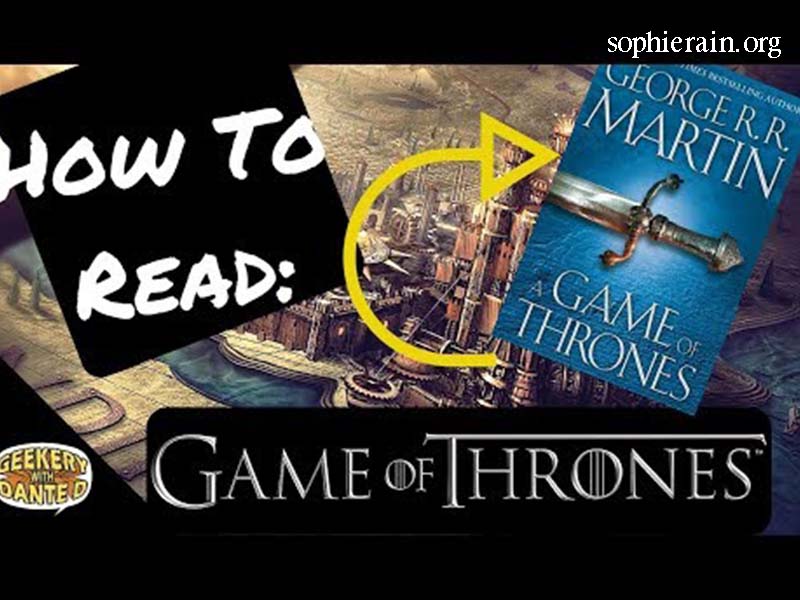When it comes to epic fantasy series, few can compare to George R.R. Martin’s A Song of Ice and Fire series, which inspired the hit television show Game of Thrones. With its intricate plots, rich world-building, and a wide array of characters, diving into the books can feel as daunting as navigating the Seven Kingdoms themselves. If you’re wondering what order to read Game of Thrones (or A Song of Ice and Fire), this article is your comprehensive guide.
Whether you’re a fan of the show looking to experience the story in its original literary form or a newcomer to the world of Westeros, the sequence in which you read the books can make a significant difference. In this article, we’ll explore the most recommended reading order, tips for pacing, and insight into the intricate narrative structure of the series, all while ensuring you have the best experience possible.
Why the Order You Read Game of Thrones Matters
Before delving into the specifics, it’s important to understand why the reading order matters. George R.R. Martin’s A Song of Ice and Fire series is not a simple, linear tale. The books are filled with shifting perspectives, parallel storylines, and numerous character arcs that span vast distances and multiple continents. Reading in the right order allows you to grasp the story’s complexities, avoid spoilers, and experience the world-building in a gradual and immersive way.
The Best Order to Read Game of Thrones (A Song of Ice and Fire)
The recommended order to read the Game of Thrones books is chronological based on the release dates of the series. This allows readers to follow the story in the sequence George R.R. Martin intended, while also building anticipation for each new book’s release.
1. A Game of Thrones (1996)
The journey begins with A Game of Thrones, the first book in the A Song of Ice and Fire series. It introduces readers to the fictional world of Westeros, where noble families battle for power, all while facing threats from beyond the Wall. The primary focus is on the Stark family, who rule the northernmost region of the Seven Kingdoms, and their interactions with the Lannisters, a wealthy and cunning family from the south.
In this book, readers are introduced to iconic characters like Jon Snow, Daenerys Targaryen, Tyrion Lannister, and Eddard Stark, whose fates become central to the series. Starting with A Game of Thrones is essential to understanding the political and personal dynamics that unfold in later installments.
2. A Clash of Kings (1998)
The second book, A Clash of Kings, picks up the story immediately after the events of the first. In the wake of King Robert Baratheon’s death, various claimants vie for the throne, leading to the War of the Five Kings. The characters’ fates become more intertwined as alliances are forged and broken.
This book expands the world of Westeros, focusing on key battles, such as the Battle of Blackwater, and deepens the exploration of each character’s motivations. A Clash of Kings builds the tension as it sets the stage for more significant conflicts to come.
3. A Storm of Swords (2000)
Widely considered one of the best installments of the series, A Storm of Swords is packed with shocking twists, betrayals, and character developments. This book brings major plotlines to a head, including the infamous Red Wedding, which alters the course of the series forever. Themes of revenge, loyalty, and survival are at the forefront as the Stark and Lannister families continue their bitter feud.
The stakes are raised considerably in this book, and it’s where the political intrigue of the earlier books begins to blend with the larger, existential threats facing the kingdom.
4. A Feast for Crows (2005)
The Feast for Crows takes a step back from the action-packed plot of A Storm of Swords and shifts focus to new characters, locations, and events that build upon the already established storylines. The book primarily follows the aftermath of the War of the Five Kings and explores the rebuilding of Westeros after the chaos of battle.
This installment is slower-paced but provides necessary character development, especially for key figures like Brienne of Tarth, Samwell Tarly, and the politics of the Ironborn.
5. A Dance with Dragons (2011)
Released six years after A Feast for Crows, A Dance with Dragons runs parallel to the events of the previous book, focusing on other characters whose stories were not addressed in A Feast for Crows. This book delves deeper into Daenerys’s journey in Essos, Jon Snow’s struggles at the Wall, and Tyrion Lannister’s fate following his escape from Westeros.
Though both A Feast for Crows and A Dance with Dragons cover similar timelines, they each offer unique perspectives and character developments that are crucial for understanding the larger narrative.
6. The Winds of Winter (TBD)
The long-awaited sixth book in the series, The Winds of Winter, has yet to be released, but it is expected to continue the story arcs left open in A Dance with Dragons. Fans are eagerly awaiting this installment, as it promises to bring significant revelations and twists in the ongoing battles for power, as well as the looming threat of the White Walkers.
The Winds of Winter is highly anticipated for its role in setting the stage for the final book in the series.
7. A Dream of Spring (TBD)
The seventh and final book in the A Song of Ice and Fire series, A Dream of Spring, will conclude the epic saga. Although details about the plot are scarce, fans expect George R.R. Martin to wrap up the numerous character arcs and open-ended storylines, providing a resolution to the centuries-long conflict for control of Westeros.
While there is no official release date for A Dream of Spring, it is expected to follow soon after The Winds of Winter, bringing the series to its much-anticipated conclusion.
Alternate Reading Order (For Show Fans)
Some fans, especially those who have already watched Game of Thrones, may prefer a slightly different approach to reading the books. For these readers, an alternate reading order that combines the two books released together (A Feast for Crows and A Dance with Dragons) might make sense, as it allows you to experience the story in a way that mirrors the show’s pacing.
However, it’s important to note that this approach might leave you with more spoilers than you would get by following the original publication order. For instance, A Clash of Kings introduces characters and events not yet depicted on the show, making it a vital part of the early storyline.
What to Expect from the Game of Thrones Series
Reading the Game of Thrones books will expose you to a much more detailed and nuanced world than what’s seen on the screen. George R.R. Martin’s world-building is rich and immersive, and the characters are far more complex and morally gray than in the show.
As you progress through the books, you’ll encounter intricate political maneuvering, powerful magical elements, and character-driven narratives that explore love, betrayal, honor, and revenge. While the TV series is famous for its shocking plot twists, the books offer even deeper insights into the characters’ motivations and actions.
Tips for Reading Game of Thrones
- Take Your Time: The books are long and detailed, so don’t rush through them. Take time to absorb the complexities of the world and enjoy the journey.
- Follow Character Arcs: Since the series features numerous characters with their own arcs, try to follow individual storylines for a better understanding of the narrative’s full scope.
- Stay Organized: Keep track of the vast array of characters and locations. It can be helpful to make notes or use a character guide to avoid confusion.
Conclusion: Read Game of Thrones in the Right Order
To get the most out of your reading experience, it’s essential to follow the right order when diving into the Game of Thrones books. Start with A Game of Thrones and follow the chronological release order to understand the full scope of George R.R. Martin’s epic tale.
By reading in this way, you’ll not only stay true to the author’s intended storytelling progression but also ensure that you avoid spoilers and experience the gradual build-up of tension, drama, and intrigue that defines the series. Enjoy your journey through Westeros, and may you come out victorious in your reading adventure!






